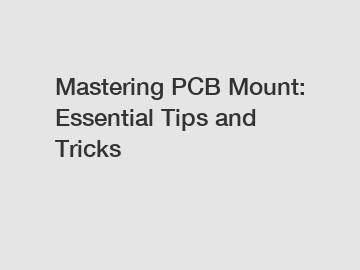Mastering PCB Mount: Essential Tips and Tricks
Welcome to the world of PCB mount! If you are an electronics enthusiast or a professional engineer, mastering PCB mount techniques is essential for designing and manufacturing efficient printed circuit boards. In this blog, we will delve into some essential tips and tricks that will elevate your PCB mount game to new heights. Our goal is to help you enhance your skillset and deliver impeccable results. So, let's dive right in!
1. Choose the Right Mounting Technique:
When it comes to PCB mount, selecting the appropriate mounting technique is crucial. There are several options available, such as surface mount technology (SMT), through-hole technology (THT), and hybrid mount. Each technique has its own advantages and applications. Factors like component size, board complexity, and production volume influence the choice. The key is to analyze the requirements of your PCB design and select the most suitable mounting technique accordingly.

2. Ensure Proper Component Placement:
The importance of component placement cannot be overstated. Ensure that the components are placed optimally on the board, allowing for efficient routing and reducing the chances of signal interference. Understanding component footprint, spacing, and orientation is essential to achieve proper component placement. Also, consider the thermal dissipation and heat management aspects during placement to avoid overheating issues.
3. Pay Attention to Thermal Management:
Effective thermal management is crucial to prevent electronic components from overheating, which can lead to system failure or reduced operational lifespan. Incorporate proper heat sinks, thermal pads, or design considerations like copper pours and vias to efficiently dissipate heat generated by high-power components. Analyze the thermal profiles of your design and optimize it accordingly to ensure the long-term reliability and performance of your PCB.
4. Practice Good Grounding Techniques:
Grounding is a fundamental aspect of PCB design. Proper grounding techniques enhance the signal integrity, reduce electromagnetic interference (EMI), and improve the overall performance of the PCB. Maintaining separate ground planes for analog and digital components, using a star grounding system, and employing ground isolation techniques are some best practices to ensure a robust grounding system. A well-designed grounding system paves the way for higher accuracy and reliability of your electronic circuits.
5. Implement EMI/EMC Shielding:
Electromagnetic interference (EMI) and electromagnetic compatibility (EMC) issues can cause disruptions in the functioning of electronic circuits. Shielding measures should be implemented to minimize these interference problems. Ensure that sensitive components are adequately shielded, and proper signal routing techniques are employed to minimize cross-talk. By incorporating EMI/EMC shielding techniques right from the initial design phases, you can ensure a flawless end product.
6. Employ Design for Manufacturing (DFM) Guidelines:
PCB designs should adhere to Design for Manufacturing (DFM) guidelines, which facilitate the smooth transition from design to the production phase. By keeping DFM guidelines in mind during the design process, you can minimize errors, potential manufacturing issues, and unnecessary rework. Consider factors like PCB stack-up, panelizing, solder mask design, and component selection to optimize the manufacturability of your PCB.
Conclusion:
Mastering PCB mount techniques is a crucial step towards achieving excellence in electronics design and production. By implementing the tips and tricks discussed above, you can enhance the quality, reliability, and performance of your PCBs. Remember, proper component placement, efficient thermal management, robust grounding, EMI/EMC shielding, and adherence to DFM guidelines play a vital role in creating impeccable PCB designs. Stay curious, keep learning, and push the boundaries of creativity to become a true master of PCB mount techniques. Let your passion for electronics soar, and let your PCB designs set new benchmarks of excellence!
The company is the world’s best Industrial Control PCB Manufacturer, consumer electronics pcb , Lead Free HASL PCB supplier. We are your one-stop shop for all needs. Our staff are highly-specialized and will help you find the product you need.
133
0
0


Comments
All Comments (0)